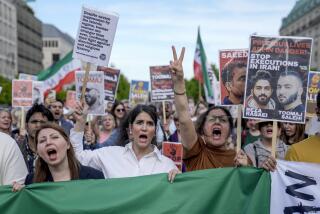Three Who Fled Iran Display Marks of Prison Torture : Young Opponents of Khomeini Wear Scars as Badges
- Share via
WASHINGTON — In the living room of a suburban Virginia tract house, three Iranians on Sunday displayed marks of torture that they said they had suffered solely because they opposed the regime of the Ayatollah Ruhollah Khomeini.
Mojgah Homayounfar, 24, a former high school math teacher, removed an artificial limb as she described how a police machete had hacked off her left leg below the knee. Another former teacher, Narges Shayesteh, 27, showed angry red scars on her chest, which she said were cigarette burns inflicted during torture in four prisons where she spent 2 1/2 years.
She also showed her knees, which she said have remained swollen since they were tied together and she was suspended by a rope for 48 hours.
Hussein Dadkhah, 29, a former graduate student in engineering, peeled off his socks to show toes that he said had been partly burned off. Despite this mutilation, he said, he eluded his guards during a prison transfer and fled into Tehran’s crowded central railway station in February, 1983.
‘Thousands Saw Me’
“Thousands of people saw me, but nobody told the guards which way I had gone,” Dadkhah said.
All three said they escaped from Iran with the help of the Moujahedeen, the underground Islamic socialist organization that is trying to topple Khomeini’s Muslim fundamentalist regime. They were sheltered by Moujahedeen cells, they said, until they were able to cross the border. Dadkhah said he did not reach the safety of neighboring Pakistan until December, 1983.
Shayesteh said she was brought to prison on a stretcher in September, 1980, after Khomeini’s paramilitary Revolutionary Guards attacked her family’s home in Tehran and severely beat her relatives. She said she witnessed mass executions in prison and, like her companions, was scheduled to die herself, although neither she nor any of her fellow prisoners ever was put on trial. In July, 1983, she said, her jailers brought her infant niece to Ghezel Hesar Prison west of the capital in an effort to persuade her to denounce the Moujahedeen.
“In the confusion of the arrival of some more prisoners, I took the child in my arms and walked out, telling the guards that I was the mother who had come to see my sister,” Shayesteh recounted. “I got on the first vehicle I saw, a truck, and left. When we got to the town of Karaj, I left the baby at a shop, told the people who she was and continued on to Tehran.”
She made her way to freedom via Pakistan and eventually reached Paris, where the others also found refuge. They were brought to the United States last week by Moujahedeen representatives to testify before a committee of the U.N. General Assembly. The effort was blocked by Iran’s U.N. ambassador, but the committee adopted a resolution critical of human rights abuses by the Khomeini government.
Homayounfar said she was interrogated by police about her support for Moujahedeen leader Massoud Rajavi after her arrest in September, 1981. She said that she was tortured and that, because she recognized a policeman, he hacked off her leg with a machete.
“They obviously thought I would bleed to death, so they left me on the ground and ran over me as they went,” Homayounfar said. “People found me and took me to a hospital. My knee was in eight pieces and my right leg completely crushed.”
Publicity about the case brought the Revolutionary Guards to the hospital, she said. “They threatened to kill me if I talked and finally took me to prison.”
Homayounfar, an art student, has painted scenes of Tehran’s infamous Evin Prison and of executions she witnessed. One execution, she said, was that of Nadia Kaviani, a former engineering student at UC Berkeley, who was so brutally tortured that she was unable to stand and had to be tied to a post to be shot.
Homayounfar was released last year because, like many prisoners, she had contracted tuberculosis, she said. In July, 1985, she was smuggled out of the country by Moujahedeen sympathizers.
More to Read
Sign up for Essential California
The most important California stories and recommendations in your inbox every morning.
You may occasionally receive promotional content from the Los Angeles Times.













